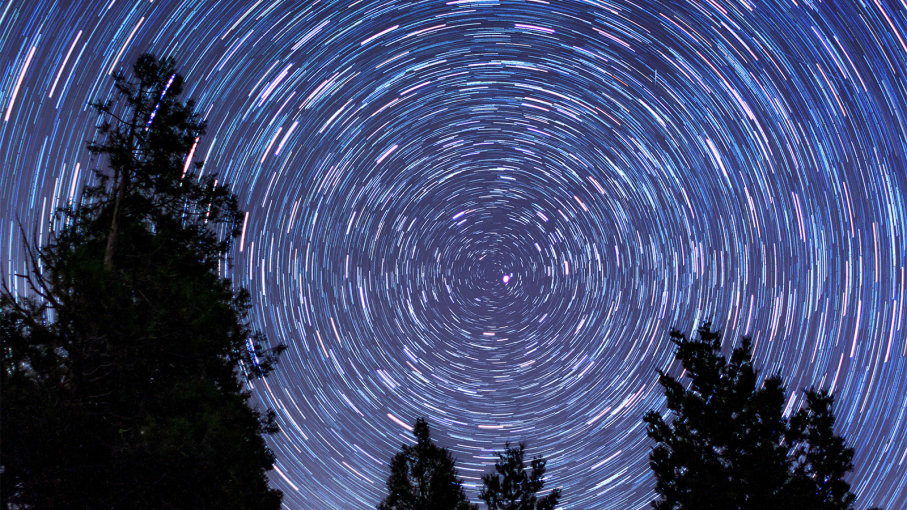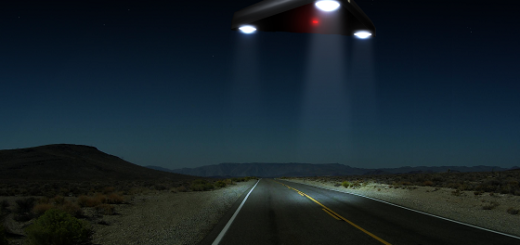Why Is the North Star So Stellarly Important

If you ever looked at the night sky in the Northern Hemisphere, you’ve noticed that gleaming object that the rest of the heavens appears to move around. What you’re seeing is Polaris, also known as the North Star, which is approximately 430 light years away from Earth and is part of the constellation Ursa Minor.
The North Star is called that because its location in the night sky is almost directly over the North Pole, according to Rick Fienberg, a Harvard-trained astronomer who now is press officer of the American Astronomical Society.
Polaris Doesn’t Rise and It Doesn’t Set
“So, if you were to stand at the North Pole — latitude 90 degrees north — at night and look straight up, you’d see Polaris directly overhead,” Fienberg says via email. “From other latitudes in the Northern Hemisphere, if you face due north at night and look the same angle above the horizon as your latitude (for example, look about halfway up – 45 degrees – if you live in Portland, Oregon, at latitude 45 degrees north), you’ll see Polaris shining there.”
Polaris is attention-getting, because unlike all the other stars in the sky, Polaris is in the same location every night from dusk to dawn, neither rising nor setting, according to Fienberg. Its looming presence leads some people to think of it, mistakenly, as the brightest star in the sky (it’s actually the 48th brightest). Even so, it’s about 2,500 times as luminous as our sun, because it’s a massive supergiant with a diameter nearly 40 times larger than the sun and five times the mass. But Polaris also happens to be far away for a star that’s visible with the naked eye, which reduces its brightness.
Who First Found the North Star?
Who discovered the North Star? That’s a complicated question. Ancient Egyptian astronomers in the Old Kingdom, between 4,700 and 4,100 years ago, had a North Star, which they symbolically represented with a female hippopotamus, according to Giulio Magli’s book “Architecture, Astronomy and Sacred Landscape in Ancient Egypt.” But it wasn’t Polaris.
That’s because what humans perceive as the North Star changed over time. “If you picture a line connecting Earth’s North and South Poles as the axis around which Earth rotates, that axis is slowly moving in its own circle,” explains Christopher Palma, a former teaching professor in astronomy who currently is associate dean of the Eberly College of Science at Penn State University, in an email. “Often, this is compared to what happens when a top or a spinning coin start to ‘wobble’ before falling over on their side. We say that Earth’s North Pole is ‘precessing,’ that is, the line that goes from the North Pole to the South Pole traces out a circle with a period of 26,000 years.”
As a result, “over very long time periods (more than a few thousand years), the North Pole moves with respect to the stars,” Palma continues. “So thousands of years ago, people on Earth saw the star Thuban in [the constellation] Draco appear due north, instead of Polaris.”
The North Star in Navigation
Polaris seems to have been first charted by the astronomer Claudius Ptolemy, who lived from about 85 to 165 B.C.E. The star’s location close to the celestial North Pole eventually became useful to navigators.
“At night, in the Northern Hemisphere, if you can see Polaris you can always tell which way is north (and, by extension, which ways are south, east and west),” Fienberg says. “It’s true now, it’s been true for hundreds of years (including during the Age of Exploration in the 15th through 17th centuries), and it’ll be true for hundreds more years. You can also tell your latitude, since the angle from the horizon to Polaris is the same as your latitude (to within a degree, anyway). Once you travel south of the equator, though, Polaris drops below the horizon, so it’s no longer useful as a navigation aid.”
Additionally, a navigator using Polaris has to take into account that the star isn’t precisely over the North Pole but instead has an offset of 39 arc-minutes, explains Rich Schuler, a lab manager and adjunct faculty member who teaches astronomy at the University of St. Thomas in St. Paul, Minnesota, in an email interview. (He’s author of this 2002 primer on the North Star in Scientific American.) That corresponds to an error of 44.7 miles (72 kilometers), he says.
Here’s Why the North Star Twinkles
One of the other things that’s intriguing about Polaris is that it’s what astronomers refer to as a Cepheid Variable star. “This star pulsates because it is in a state that is unstable,” says Palma. “It will swell up, and when it does, an outer layer of the star becomes transparent, which then makes the star cool off. As a result of it cooling off, it will shrink until it becomes opaque again, which causes it to heat up and swell again. It will do this over and over again, pulsating in and out, which causes its brightness to fluctuate.”
And although you can’t tell when you gaze at Polaris in the night sky, it’s actually part of a triple star system. “The two fainter stars (Polaris Ab and B) do not vary in brightness because they are on the ‘main sequence,’ or are generating energy by fusing hydrogen nuclei into helium nuclei only in the core of the star,” Schuler explains.
Polaris won’t be the North Star forever. “If you look at the 14,000 C.E. point, you’ll see a star that’s much, much brighter than Polaris but farther from the circle,” Fienberg says. “That’s Vega, which our descendants some 12,000 years from now (if humans are still around) will consider their North Star.”



 Creators of mankind
Creators of mankind Description of “Tall white aliens”
Description of “Tall white aliens” Where they came from?
Where they came from? About hostile civilizations
About hostile civilizations The war for the Earth
The war for the Earth “Tall white aliens” about eternal life
“Tall white aliens” about eternal life Video: “Nordic aliens”
Video: “Nordic aliens” Aliens
Aliens Alien encounters
Alien encounters The aliens base
The aliens base UFO
UFO Technology UFO
Technology UFO Underground civilization
Underground civilization Ancient alien artifacts
Ancient alien artifacts Military and UFO
Military and UFO Mysteries and hypotheses
Mysteries and hypotheses Scientific facts
Scientific facts


















